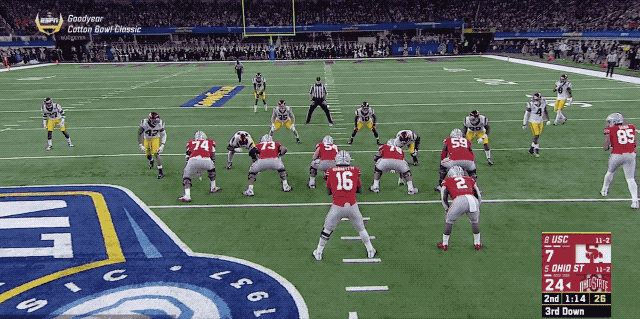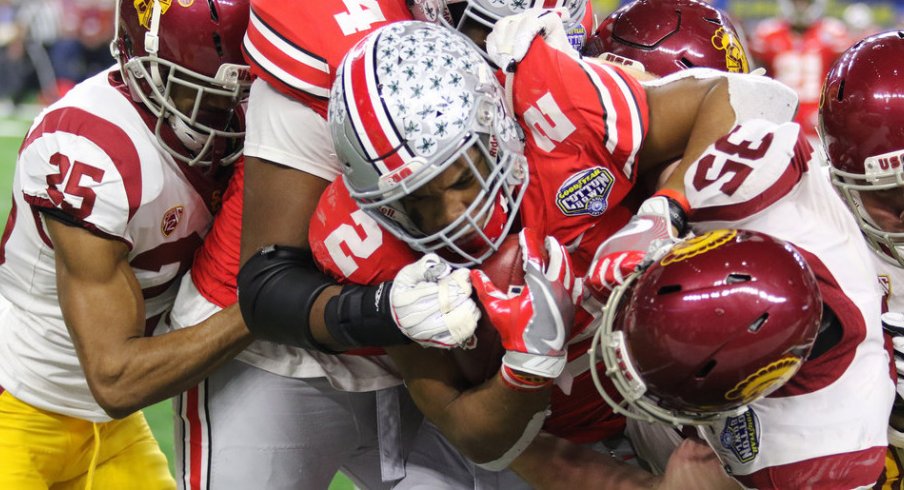"For the most part, I think they did a lot of what we saw on film." - USC linebacker Cameron Smith following the Cotton Bowl.
Ohio State fans hoping to see their favorite team light up the scoreboard in the final act of the 2017 campaign must've been disappointed. Despite building a 24-7 lead at halftime thanks to three USC turnovers, the Buckeyes failed to grow that margin throughout the duration of the contest, leaving some to actually express gratitude to the playoff committee for sparing the team from another potential embarrassment similar to last year's Fiesta Bowl debacle.
While Urban Meyer's offense certainly performed better in this year's bowl appearance, it failed to live up to the billing as one of the top ten units in the nation, one that averaged 506 yards-per-game. But while OSU also got out to a big, early lead in their previous game, the Big Ten Championship victory over Wisconsin, the Badgers' top-ranked defense eventually slowed the Buckeyes' explosive attack in the second half. Yet the Trojans, who feature only the 68th-best defense in the land, somehow held the team from Columbus to 172 fewer yards in the Cotton Bowl.
Though the Ohio State defensive line was largely credited with the victory, sacking star USC quarterback Sam Darnold eight times and forcing him into the aforementioned turnovers, the Trojan defense accomplished their goal through a variety of means. As noted by Smith, the Buckeyes tried to establish the tight zone run, the foundational concept upon which much of the system is based. However, USC defensive coordinator Clancy Pendergast unveiled a new wrinkle that kept star center Billy Price from helping his guards with the critical combination blocks on the nose tackle that make the play go.
Instead of lining up in their traditional spots behind the defensive line, Smith (#35) and WILL linebacker John Houston (#10) regularly lined up directly over both of Price's shoulders in the 'A' gap. Sometimes one or both would blitz (with an occasional safety blitz, as seen below), but other times they'd drop back at the snap into a traditional alignment.
As a result, Ohio State offensive linemen had trouble identifying their keys and were often left in one-on-one battles with quicker USC defenders looking to shoot a gap.
Despite tallying over 1,400 yards in his first year on campus, freshman running back J.K. Dobbins was largely held in check due to this tactic. In the worst performance of his young career, Dobbins tallied only 39 yards on 13 carries while fellow back Mike Weber managed only 18 yards of his own on the ground.
Taking a cue from Notre Dame, who ran all over the Trojans back in October, the Buckeyes found some success with toss sweeps from compressed formations. Pulling linemen and cracking wideouts gave Dobbins, Weber, and even quarterback J.T. Barrett some opportunities to pick up yardage outside.

Tosses weren't the only effort made to run the ball on the edges, though. 'H' receiver Parris Campbell received three handoffs that evening, with the biggest gain coming on a 21-yard end-around that initially appeared to be a triple-option (which Meyer calls Wade) with Dobbins and Weber finally sharing the same backfield.

But Campbell and fellow 'H' K.J. Hill were most useful that night for their Jet motions that drew the attention of the defensive secondary. While handoffs to the motioned receiver may have netted 21 yards that night, the real beneficiary was Barrett, who led the game with 88 yards rushing (not including yardage lost from sacks).
Instead of struggling behind the zone schemes called for the backs, Barrett found room to run behind gap schemes like Power-O.
The attention paid to the Jet motion helped in the passing game as well. As the Trojan secondary "spun" to trade responsibilities from one side to another, deep crossing routes filled the void left behind by those scrambling defensive backs.
Contrary to some narratives, Barrett actually had a solid night throwing the ball despite limited opportunities. Though he only connected for 114 yards through the air, his 11-for-17 performance matched his season-long completion rate of 64.7% thanks in large part to the efforts of sophomore Austin Mack, who reeled in 3 receptions for 53 yards.
But as you can see in the clip above, Barrett had little time to make such throws when he dropped back. The Trojans sent a myriad of blitzes toward the Buckeye backfield, regardless of down and distance.
On early downs, overload blitzes from the boundary forced Barrett to get rid of the ball before he could set his feet.

But much as Darnold was let down by his protectors against the talented Buckeye defensive line, Barrett's line experienced multiple breakdowns of their own, especially on critical third downs. The Buckeyes finished only 2-of-12 on third down conversations that night as the Trojans brought multiple blitzes at right guard Demetrius Knox and right tackle Isaiah Prince, looking to sew confusion and spring a pass rusher free to the quarterback.

Even the most basic line stunts seemed too much for that right side of the line to handle, as Knox failed to pick up edge rusher Uchenna Nwosu on this basic loop stunt. After initially sealing off the 3-technique tackle through the 'B' gap with Prince, Knox never even looked for a second rusher coming back through the 'A' gap, leaving Barrett completely unprotected.

Not all the failures were on the line, though. Perhaps due to his time splitting practice reps with Dobbins, Weber failed to pick up Nwosu right through the middle on an early third down, even though Price appears to think he has help from the back through the left 'A' gap. Instead, Weber seems more focused on releasing on a pass route instead of recognizing the rush, ending a promising drive early.

While the Trojans may have gotten what they expected from their opponents, it's clear the Buckeye offense did not. The new alignments and constant pressure from Pendergast's defensive front proved too difficult for the Ohio State offense to recognize and deliver a counter-punch in the moment, but with three-score lead in the second half, there was also little need to go deep in the playbook in order to find solutions.
Ironically, this performance was the inverse of many struggles the Buckeye offense has had since play-caller Tom Herman departed following the 2014 season. While many fans have criticized the coaching staff for leaning too heavily on Barrett as a ball-carrier in close games instead of the many play-makers around him, the senior quarterback was the most dynamic part of the entire offense in his final game in scarlet and gray.
As for what it means moving forward, the positive news is the OSU offense found ways to move the ball against the Trojans' 4-2-5 defense, which will come in handy come September when the Buckeyes return to JerryWorld to face one of the original architects of the scheme, Gary Patterson, and his TCU Horned Frogs. USC mixed up their coverages, playing versions of Quarters and Cover-3 zones along with a good amount of straight man-coverage behind all their blitz packages.
But it remains to be seen how the Buckeye offensive line rebounds from their underwhelming performance against those pressures. The two steadiest players, Price and left tackle Jamarco Jones, will be playing on Sundays next season, but luckily, opening day right guard Brandon Bowen should be back to full strength after suffering a broken leg in early October.
Yet just as anytime the Buckeyes struggle against a certain scheme or tactic, be it Virginia Tech's Bear front or Michigan State's Quarters coverage, copycats inevitably appear. Coordinators Kevin Wilson and Ryan Day along with line coach Greg Studrawa will undoubtedly spend a great deal of time examining their issues in protection against the blitz this winter because if there's one thing they know for sure, it's that they'll see many of these looks again come September. That's just life in the big city.



